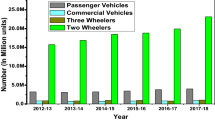Abstract
The electric power steering (EPS) system is designed to reduce the effort exerted by driver on the steering wheel. One of the most common and critical failures of EPS is the soft-disability of the torque sensor or the loss of its signal, which leads to the instant shutdown of the EPS system while turning and causes serious traffic accidents. In this paper, a novel controller based on the self-alignment torque (SAT) estimation was designed to remedy the soft-disability of EPS system. After the SAT estimation method was verified by the empirical Magic Formula (MF) tire model, the remedy control strategy based on the SAT estimation was developed and evaluated by simulations under step and sinusoidal inputs. To further evaluate the performance of the controller on a real vehicle, experiments on a real EPS system were implemented under step and sinusoidal inputs. The results of simulation and experiment using the controller based on estimated SAT showed this controller to be feasible and capable of eliminating the abrupt reaction torque increment caused by shutdown of EPS and of remedying the soft-disability of EPS system under common input signals.
Similar content being viewed by others
References
Anwar, S. and Lei, C. (2007). An analytical redundancybased fault detection and isolation algorithm for a roadwheel control subsystem in a steer-by-wire system. IEEE Trans. Vehicular Technology 56,5, 2859–2869.
Bing, Z., Cliff, A. and Sohel, A. (2005). Fault tolerant steer by-wire road wheel control system. American Control Conference, 1619–1624.
Chabaan, R. C. and Wang, L. Y. (2001). Control of electrical power assist systems: H of design, torque estimation and structural stability. JSAE Review, 22, 435–444.
Daisuke, S. and Murakami, T. (2004). Vehicle steering assist by estimated self-aligning torque in skid condition. Advanced Motion Control, IEEE Int. Workshop on AMC, 8, 269–273.
Hosaka, M. and Murakami, T. (2004). Yaw rate control of electric vehicle using steer-by-wire system. Advanced Motion Control, IEEE Int. Workshop on AMC, 8, 31–34.
Jo, J. S., You, S. H., Joeng, J. Y., Lee, K. I. and Yi, K. (2008). Vehicle stability control system for enhancing steerabilty, lateral stability, and rollstability. Int. J. Automotive Technology 9,5, 571–576.
Kim, J. H. and Song, J. B. (2002). Control logic for an electric power steering system using assist motor. Mechatronics, 12, 447–459.
Kim, D. S. and Hwang, I. Y. (2006). Control philosophy and robustness of electronic stability program for the enhancement of stability. Int. J. Automotive Technology 7,2, 201–208.
Kurishige, M., Kifuku, T., Inoue, N., Zeniya, S. and Otagaki, S. (1999). A control strategy to reduce steering torque for stationary vehicles equipped with EPS. SAE Paper No. 1999-01-0403, 654–660.
Kurishige, M., Wada, S., Kifuku, T., Inoue, N., Nishiyama, R. and Otagaki, S. (2000). A new EPS control strategy to improve steering wheel returnability. SAE Paper No. 2000-01-0815, 1–6.
Kurishige, M. and Kifuku, T. (2001). Static steering-control system for electric-power steering. Mitsubishi Electric Advance Technical Reports, 18–20.
Lee, J. H., Lee, J. W. and Sung, I. C. (2005). Road crown, tire, and suspension effects on vehicle straight-ahead motion. Int. J. Automotive Technology 6,2, 183–190.
Pacejka, H. B. (2002). Tire Mechanics and Vehicle Dynamics. 2nd Edn. Netherlands. 6–7.
Parmar, M. and Hung, J. Y. (2004). A sensorless optimal control system for an automotive electric power assist steering system. IEEE Trans. Industrial Electronics 51,2, 290–298.
Schoener, H. P. and Hille, P. (2000). Automotive power electronics-new challenges for power electronics. IEEE Annual Power Electronics Specialists Conf., 31, 6–11.
Yih, P., Ryu, J. and Gerdes, J. C. (2004). Vehicle state estimation using steering torque. American Control Conf., 2116–2121.
Author information
Authors and Affiliations
Corresponding author
Rights and permissions
About this article
Cite this article
Li, X., Zhao, X.P., Chen, J. et al. Controller design for soft-disability remedy of the electric power steering system. Int.J Automot. Technol. 10, 497–503 (2009). https://doi.org/10.1007/s12239-009-0057-6
Received:
Revised:
Published:
Issue Date:
DOI: https://doi.org/10.1007/s12239-009-0057-6




